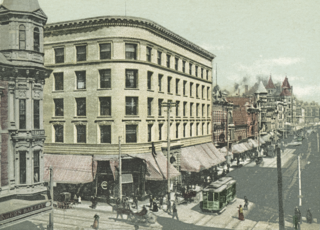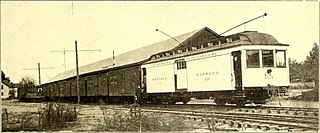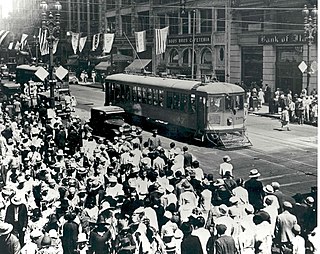Evergreen Avenue Line
Line 33 started as a new service in 1920, formed from tracks on Euclid, 4th, and Evergreen. The line served as a branch of the F. By 1924, the route was extended north to terminate at Ramona Boulevard and Miller Avenue. [2] [3]
This line designation was changed to the letter E for service starting May 19, 1939. After June 30, 1946, the route was changed to bus operations. [1]

La Grande Station was the Atchison, Topeka and Santa Fe Railway's main passenger terminal in Los Angeles, California from 1893 until the opening of Union Station in 1939. The station was located at 2nd Street and Santa Fe Avenue on the west bank of the Los Angeles River, just south of the First Street viaduct built in 1929.
The Pasadena Short Line was a line of the Pacific Electric Railway, running from 1902 until 1951, between Downtown Los Angeles and Downtown Pasadena, California. The route went through Eastside Los Angeles along the foot of the eastern San Rafael Hills to the western San Gabriel Valley.
J was a streetcar line in Los Angeles, California. It was operated by the Los Angeles Railway from 1911 to 1945, by Los Angeles Transit Lines from 1945 to 1958, and by the Los Angeles Metropolitan Transit Authority from 1958 to 1963.

P was a streetcar line in Los Angeles, California. It was operated by the Los Angeles Railway from 1895 to 1958, and by the Los Angeles Metropolitan Transit Authority from 1958 to 1963.
V was a streetcar service in Los Angeles, California. It was operated by the Los Angeles Railway from 1920 to 1958, and by the Los Angeles Metropolitan Transit Authority from 1958 to 1963.
5 or the 5 Car was a streetcar line operated by the Los Angeles Railway, later named the Los Angeles Transit Lines, and by the Los Angeles Metropolitan Transit Authority. From 1920 to 1932, this route was known as the E Car. This was changed as part of a method to distinguish routes that lacked loops at their termini. Consequently, the 5 Car was unique during the LAMTA era in that it did not use PCC streetcars. It used buses from 1955 to 1964, transferring from LATL in 1958, then splitting the line in two in 1961, until all lines were turned over to SCRTD in August 1964.

7 was a streetcar line in Los Angeles, California. The service was operated by the Los Angeles Railway from 1932 to 1955. It ran from Spring and 2nd Streets to Athens and 116th Street, by way of Spring Street, Main Street, Broadway Place, Broadway, and Athens Way. During its Los Angeles Transit Lines days, around 1950 to 1955, Line 7 was rerouted off South Broadway to Central Avenue, at least as far north as 7th Street across Olympic Boulevard to possibly Vernon Avenue, covering trackage that was abandoned rail by line U, when that line was converted to trolley bus August 3, 1947.
8 was a streetcar line in Los Angeles, California. It was operated by the Los Angeles Railway from 1932 to 1955.
9 was a streetcar line in Los Angeles, California. It was operated by the Los Angeles Railway from 1932 to 1955.

F was a streetcar line in Los Angeles, California. It was operated by the Los Angeles Railway from 1911 to 1955.
3 was the number assigned to two distinct streetcar lines operated by the Los Angeles Railway in Los Angeles, California. Combined, they operated from 1924 to 1947.
The B was a streetcar line in Los Angeles, California. It was operated by the Los Angeles Railway from 1920 to 1949, originally running from Ramona Boulevard and Miller Street in East Los Angeles to Ascot Avenue and 51st Street.
10 refers to two streetcar lines in Los Angeles, California. They operated by the Los Angeles Railway for a combined period from 1932 to 1946.
A refers to several streetcar routes in Los Angeles, California. The lines were operated by the Los Angeles Railway from 1920 to 1946.
C refers to two streetcar routes in Los Angeles, California. The lines were operated by the Los Angeles Railway from 1910 to 1932.
G refers to several streetcar routes in Los Angeles, California that ran via Griffith Avenue. The lines were operated by the Los Angeles Railway from 1910 to 1946.
2 was a designation given to several transit lines in Los Angeles, California. The number was assigned to a streetcar route in 1930 which lasted a year, then later reassigned to a new service in 1932. Trolley buses replaced streetcars in 1941, and the line was converted to full motor coach operation in 1963.
4 was the number assigned to two distinct streetcar lines operated by the Los Angeles Railway in Los Angeles, California.
L was a streetcar line in Los Angeles, California. It was operated by the Los Angeles Railway from 1920 to 1940.

M refers to several streetcar routes in Los Angeles, California. The lines were operated by the Los Angeles Railway from 1917 to 1941.




